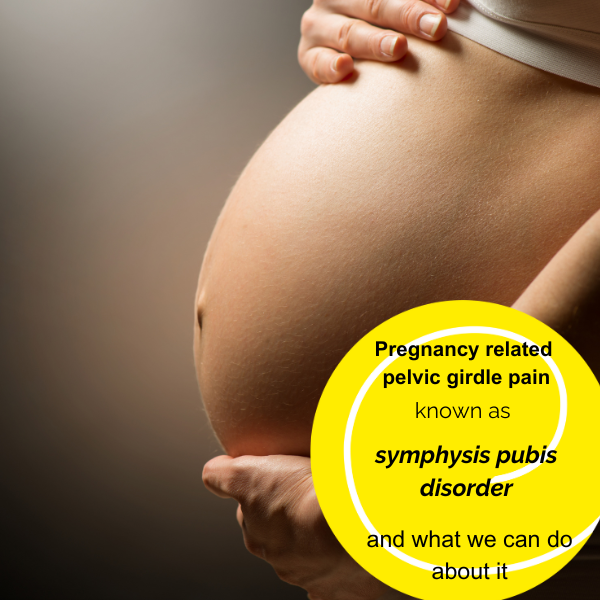Pregnancy related pelvic girdle pain, also known as Symphysis Pubis Disorder (SPD), describes multiple symptoms of discomfort around the front or the back of the pelvic joint that women may experience during pregnancy. Research supports that 30% of women experience SPD throughout their pregnancy. So, what causes SPD and what can we do about it?
The pelvis is a ring of bones that connects the trunks to the legs. It is made of 3 joints: two sacroiliac joints at the back and one pubic symphysis at the front. Either from early on during the first trimester or more commonly during the third trimester, women may experience pain in any of these joints and is referred as Symphysis Pubis Disorder (SPD).
The symptoms of SPD can be widely diverse in both presentation and severity. The pain can vary from being centrally located at the front of the pelvis, to radiating off to one side along the groin or inner thighs, or sometimes can also be more widely felt across the whole pelvic area. The pain can range from tenderness to touch, to a deep burning pain, a shooting pain or a grinding/clicking sensation. Some women only report mild discomfort, while others’ quality of life can be severely impacted from experiencing debilitating pain during simple things such as walking, getting out of the car, rolling in bed etc.
What causes SPD?
Significant anatomical and physiological changes occur within the women bodies during pregnancy to accommodate to the growing baby and prepare mothers for labour and birth. Although those rapids changes are normal, they can be contributing factors of SPD.
As pregnancy progresses, women’s body must adapt to those rapid changes. The expecting mother’s centre of gravity shifts forward and as a result, the lumbar curves increases and the pelvis tilts forward.
The uterus also expands to accommodate the growing baby. As the uterus is anchored to the back and front of the pelvis, any dysfunction of these joints may increase torsion of the uterus, tension of the round and broad ligaments which can result in pain and affect baby’s positioning.
During pregnancy, a reproductive hormone called Relaxin is released to provide laxity for the joints and ligaments in preparation for birth. As the pelvic joints become more mobile than they usually would be, it can create instability and pain of the normally rigid pubic symphysis.
The benefits of chiropractic care for the management of SPD
The human body has this incredible ability to heal and adapt. The amazing human body is also designed to grow and birth a baby! To do so effectively, the body relies on optimal communication between the brain and the body via the nerve system.
Every second of every minute, the brain receives information from its internal environment (all cells and organs from inside our bodies) and external environment (the outside world) via sensory receptors up the nerves and the spinal cord. The brain then processes those messages and send replies back down the spinal cord out the nerves to tell the body how to respond. This constant highway of communication between the brain and the body allows proper function.
Our delicate nerve system is protected by the spine. Day to day physical or emotional stressors, as well as pregnancy related stressors can impact the function of our spine and nerve system. Dysfunction of these can reduce our bodies ability to adapt to the massive changes the body undergoes during pregnancy and can result in pain such as lower back pain, round ligament pain or SPD.
Chiropractors are health professionals who specialise in the function of the spine and the nerve system. Our role is to locate and correct dysfunction of the spine to restore optimal nerve system function. By supporting effective brain/body communication, the body can better adapt and gain resilience to the physical and emotional stresses linked to pregnancy. Research supports that chiropractic care is effective at reducing pregnancy related discomfort, as well as optimising baby’s positioning and facilitate a straightforward labour.
Chiropractic care is safe for expecting women and your EBC chiropractors will modify the way they adjust you, so it is adequate to your needs throughout your pregnancy. Aside from checking and accordingly adjusting your spine and nerve system, they may recommend common activities modifications to reduce stress on the pubic symphysis and strengthening exercises to stabilise your pelvis. If required, they may also recommend external support such as a sacroiliac belt or refer you to a physiotherapist for pelvic floor evaluation.
Although SPD is a common symptom occurring during pregnancy, it is not normal! If you suspect you might be experiencing SPD or simply want to function at your best to navigate pregnancy and birth, get in touch with us, our team would love to help.
Dr. Julie
References:
Depledge J, McNair PJ, Keal-Smith C, Williams M. Management of symphysis pubis dysfunction during pregnancy using exercise and pelvic support belts. Physical Therapy. 2005;85(12):1290–1300
Wang S.M., DeZinno P., Fermo L. Complementary and alternative medicine for low-back pain in pregnancy: a cross-sectional survey. J Altern Complement Med. 2005;11(3):459–464 Complementary and alternative medicine for low-back pain in pregnancy: a cross-sectional survey.
Borggren, C. L. (2007). Pregnancy and chiropractic: a narrative review of the literature. Journal of Chiropractic Medicine, 6(2), 70–74. https://doi.org/10.1016/j.jcme.2007.04.004

